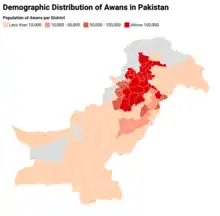Qutb Shah
Syed Qutb Shah Gilani, formally known as Syed Abdullah Awn ibn Ya‘lā (Persian: عبداللہ عَوْن ابنِ یعلیٰ) (c. 1028–1099), was a ruler,[1] medieval Persian Sufi, Muslim preacher and a religious scholar.[2] He had the Alid lineages, through his father and mother respectively, and was also the cousin of Abdul Qadir Gilani.[3][4]
Abdullah Awn ibn Ya‘lā عبداللہ عَوْن ابنِ یعلیٰ | |
|---|---|
| Born | 1028 AD (probably) Gilan, Persia |
| Died | 1099 AD (probably) present-day Herat, Afghanistan |
| Other names | Hakim-ul-Quloob, Al-Sheikh Al-Azeem, Olad-e-Ali, Shamsheer-e-Sher-e-Shamsheer zan |
| Occupation(s) | Ruler and Islamic Scholar |
| Known for | Sufi mysticism |
| Title | Qutb Shah |
| Parent |
|
| Relatives | Abdul Qadir Jilani (maternal cousin) |
| Family | Banu Hashim |
Initially, he belonged to the Imamia sect of Islam, but later he was influenced by the teachings of his cousin, Abdul Qadir Gilani, and ended up becoming a Hanbali-Zaydi.[2] His Hanbali-Zaydi Sufi school tried to integrate perfectionism of commandments and agape-oriented activism. Ibn Arabi also tried this synergy by admiring Ibn Hazm which raised legal paradoxes and became controversial in ultranomian circles.[5]

Qutb Shah, in first quarter of 11th century, ruled Herat (then Awan-e-Khurasan),[1] where supposedly there was a power vacuum, and people made him their ruler due to his religious stature. After taking the throne of Herat, he also joined forces with Mahmud of Ghazni when Mahmud invaded Sub-continent.[6][1] He ruled Herat until his death. All of his children migrated to modern-day Pakistan, and settled near Salt Range, on his command.[1]He is buried in Iraq near Imam Musa Kazim.
References
- Bahri, Hardev (1963). Lahndi Phonetics, with Special Reference to Awáṇkárí. Bharati Press Prakashan. pp. 10 and 11.
- Mohammad Sarwar Khan Awan, Wadi Soon Sakaser publisher Lok Virsa Islamabad Pakistan 2002, ISBN 969-503-285-0.
- "حمزة بن القاسم بن علي". qadatona.org.
- Dr AH Dani Early Islamic Preachers in Central Asia and Northern Pakistan Monograph, Islamabad, 1976, pp 11–12
- "Al-Anṣārī, ʿAbdallāh". April 2019.
- "Journal of Central Asia". Journal of Central Asia. Centre for the Study of the Civilizations of Central Asia, Quaid-i-Azam University. 19–20: 150. 1996 – via The University of Virginia.
Before the arrival of Awan tribe, the valley was part of the state under the rule of Janjua Rajputs. They were forcibly ousted by the Awans. The Awans claim that their ancestor, Qutb Shah came along with the army of Sultan Mahmood of Ghazna in the 10th century. He headed some troops of Alavids who had been given the title of Awans ...